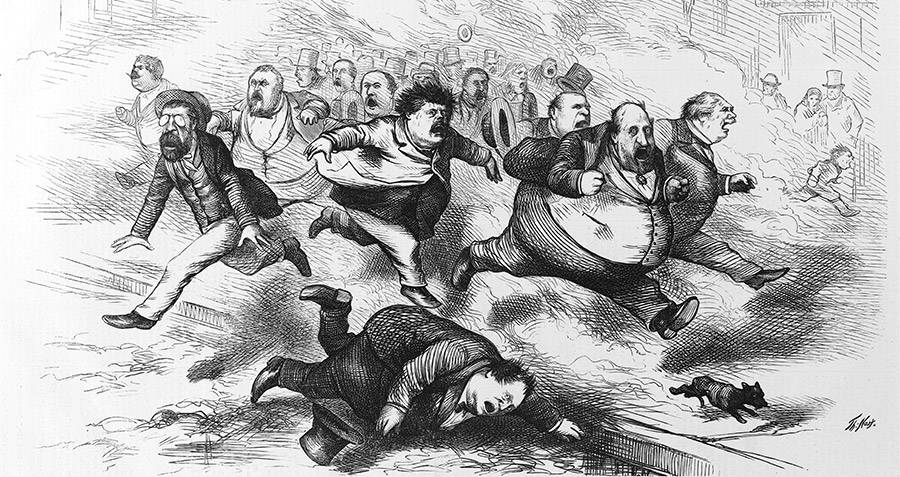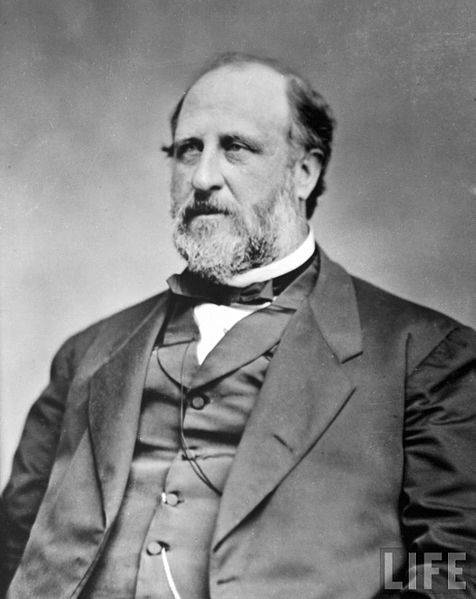From rigged elections to using the muscle of the city's gangs, Tammany Hall's Boss Tweed was the state's most corrupt politician in history.

Interim Archives/Getty ImagesCopy of an engraving depicting William ‘Boss’ Tweed and members of his corrupt Tammany Hall ring running from the New York City Treasury, mimicking the crowd in pursuit of a thief, all the while thinking and looking like they are the object of the chase, October 1871.
Tammany Hall, the New York Democratic political organization, is best known for its scandals, corruption, embezzlement, fraud, and rigged elections. At the heart of it all was William Magear Tweed, nicknamed “Boss Tweed”, the corrupt politician behind the Tammany Hall party machine from the height of its power in 1868 to his eventual downfall in 1871.
At a time when volunteer fire companies were fiercely competitive and sharply divided along immigrant communities, Boss Tweed rose to prominence as a Foreman in the Big Six Volunteer Fire Company. His violent tactics and competitive nature caught the attention of the Democratic political machine.
They nominated him to run for city alderman and he was elected to his first political office at the age of 28. Running on the Democratic ticket, he was elected to Congress in 1852. Although his term there was unremarkable, his political influence in New York City continued to grow.
In 1856, he was elected to the Board of Supervisors, and by 1860 he was head of Tammany Hall’s general committee. That same year, he opened a law office, despite not having any training as a lawyer, and collected thousands of dollars of payments for “legal fees,” which in reality were extortion payments for illegal services.

Wikimedia CommonsWilliam “Boss” Tweed
In 1868, Tweed became a state senator and the grand sachem of Tammany Hall. By this point, he and his cronies, the notorious Tweed Ring, controlled all major nominations, and he was able to have all of his candidates for mayor, governor, and speaker of state assembly elected.
In 1870, Tweed pushed to create a board of audit, effectively controlling the city treasury. The Tweed Ring set up a variety of schemes, such as faked leases, unnecessary repairs, and overpriced goods, to launder hundreds of thousands of dollars of city funds.
Voter fraud and rigged elections were also rampant, and Tweed elected many of his friends to other influential positions. To enforce his rule, Tweed would use the muscle of the Dead Rabbits and other gangs throughout the city.
Boss Tweed was brought down in large part by an expose by the New York Times and Harper’s political cartoonist Thomas Nast, who were investigating the large scale of corruption among the city’s political officials. Despite their efforts, they were largely unsuccessful until the election of 1871, when the public began to turn on Boss Tweed and the Tammany Hall machine.

Wikimedia CommonsA cartoon by Thomas Nast.
Tammany Hall’s power was largely based on the support of Irish Catholic immigrants, and, following the Orange Riots of 1871, in which Irish Protestant immigrants clashed with Catholics. During the riot, the police and the National Guard killed over 60 people and Tammany Hall came under heavy criticism. The public believed that Tammany Hall could no longer exercise control over the Irish immigrants, leaving the New York Times and Nast to break open the stories of corruption and theft.
Following the expose, a political reform movement, led by lawyer Samual J. Tildon, began to take shape. They focused their efforts on bringing down Boss Tweed and the Tweed Ring, as Tammany members lost public support and were ousted from their positions.
Leaders of the reform movement had Tweed arrested, and, after two trials, he was found guilty of larceny and forgery in 1873. He escaped in 1865 and made his way to Cuba and Spain, before being extradited and dying in a New York City jail in 1878.
Read more about Boss Tweed and Tammany Hall with this look at the real gangs of New York. Then go more in-depth and read about the Dead Rabbits gang.




